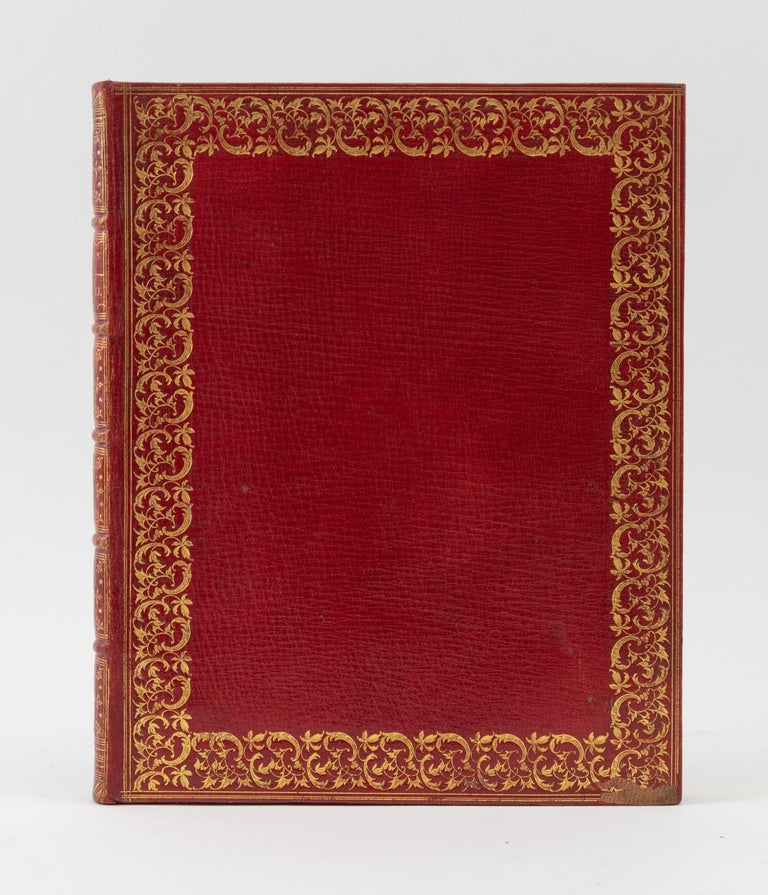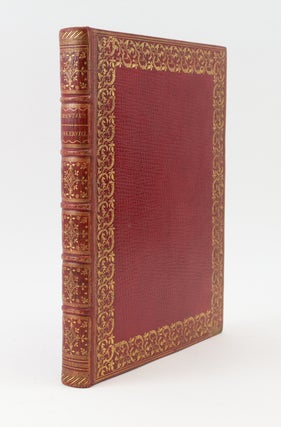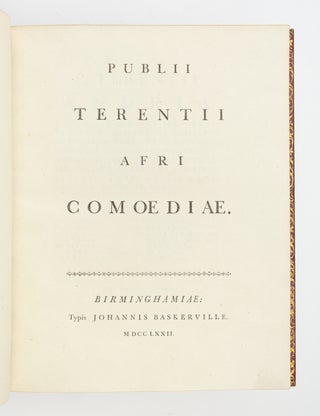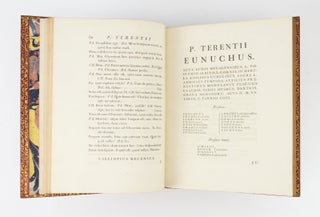COMOEDIAE.
(Birminghamiae: Typis Johannis Baskerville, 1772). 300 x 240 mm. (11 3/4 x 9 1/4"). 1 p.l., 364 pp.
ELEGANT CONTEMPORARY RED MOROCCO, GILT, covers with French fillet border and intricate frame of volutes and floral tools, raised bands, spine compartments with central lozenge radiating lancets from each corner surrounded with small flowers and leaves, oblique leafy branch at each corner, gilt lettering, turn-ins with floral roll, marbled endpapers, all edges gilt. Front pastedown with armorial bookplate of V. H. Wilmot, Esq.; front free endpaper with armorial Glenconner bookplate. Gaskell 46. ◆Lower corner of front board with scarcely noticeable small patch of lost patina and gilt from insect activity, just a hint of wear to joints and extremities, but still A VERY FINE CONTEMPORARY COPY, virtually perfect internally--very clean and fresh, with generous margins, and in a refined binding with no significant signs of use.
This is typographically a lovely printing as well as a distinguished edition of Terence in a very handsome contemporary binding. The second century B.C. playwright Terence is believed to have been a native of North Africa, enslaved during the Punic Wars. Brought to Rome and given his freedom, he joined the cultivated circle of Scipio the Younger. His six extant plays, the ancestors of drawing room and modern situation comedies, feature crusty fathers, rebellious sons, and smart aleck slaves whose machinations solve the playwright's intricate complications of plot. The plays were popular throughout the Middle Ages and the Renaissance, and still retain their appeal. Dibdin notes that this edition is "printed in the usually beautiful style of the impressions of ancient classical authors" issued by Baskerville. That series, known as the Baskerville Quarto Latin Classics, began with the first book to be issued by his press: the renowned Virgil, praised by Renouard, Gaskell, Dibdin, and other critics for its beauty. In a sheet dated 1760, which Baskerville issued appended to a specimen of his folio Bible, the printer discusses his proposed "Baskerville Classics": "Many gentlemen," he says, "have wished to see a sett of the Classicks . . . in the Manner, Letter, and Paper, of the 'Virgil,' already published," and he vows to print the same, with the poetical classics first. These volumes, says Reed, would "suffice had [Baskerville] printed nothing else, to distinguish him as the first typographer of his time." The beautiful typography, the luxurious paper (looking and feeling much like vellum), and the spacious design combine to give the reader a particularly gratifying feeling of strength and serenity. The stately binding, though similar to the French style of the period, was likely done in England for 18th century owner V. H. Wilmot. Our copy was later in the collection of Edward Priaulx Tennant, 1st Baron Glenconner (1859-1920). (ST17890a)
Price: $2,500.00




